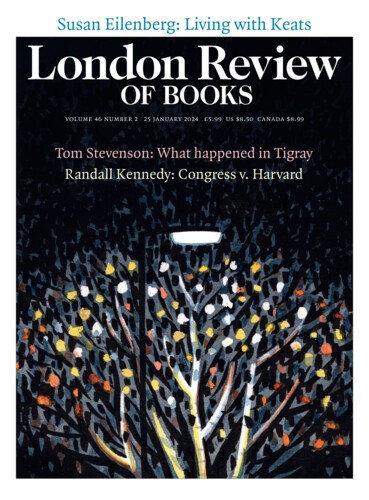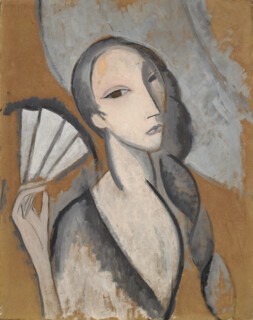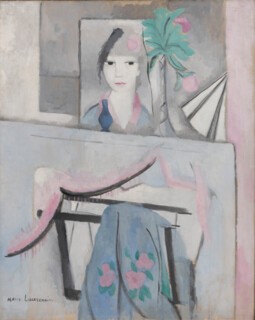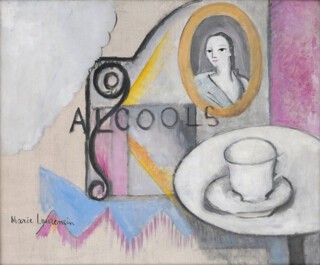During the First World War, the French artist Marie Laurencin cut off her long plaited hair and posted it to her former lover, Guillaume Apollinaire, who was serving at the front. It was an artistic as well as a personal sacrifice: interlacing serpentine lines are a recurring motif in Laurencin’s work, and femininity its primary theme. In Woman with a Fan (1912), a probable self-portrait, she rhymes the twisted coil of her braid with the unfolding pleats of a fan and the sloping curves of shoulder, neck and breast. Pablo Picasso and Jean Metzinger had both painted several pictures of women with fans in the preceding years. Laurencin’s woman, unlike theirs, locks eyes with the viewer, as if to say ‘I am a Cubist motif.’
The war – and the severed plait – marked Laurencin’s break with Apollinaire, Picasso and their group. In 1908 and 1909 she had painted herself as part of the gang, which included Gertrude Stein and Fernande Olivier, Picasso’s model and muse. In the first of these portraits, which Stein bought for her collection, Laurencin stands head and shoulders above Picasso, holding a pink rose. In the second, her flouncy blue dress distracts from the rest of the group, in sombre browns and greys. This painting shows five women and three men, but it is the men who are usually remembered. Russian Cubists such as Natalia Goncharova and Lyubov Popova have received more attention, but the exhibition of Laurencin’s work at the Barnes Foundation in Philadelphia, Marie Laurencin: Sapphic Paris (until 21 January), is one of her biggest to date. Recent retrospectives in France, Switzerland and Japan, where the founder of a taxi company collected more than five hundred of her paintings and established a museum in her honour (it closed in 2019), have not yet brought her out of the shadows.
Alcools, a painting from 1911, before Laurencin split from the group, features familiar Cubist elements – a cup and saucer on a table, a female portrait, lettering, quavering planes and incongruous scales – in a less familiar palette of pink, powder blue, lemon and gold. The zigzag that buttresses these forms and the thick outline curving around the table dissolve into a pink and black fringe across the bottom of the canvas, which itself fades into the shadow of the table – the only acknowledgment of three-dimensional space. The juxtaposition of the word ‘alcools’ and a woman’s portrait suggests the woman-in-a-drinking-establishment genre of modern French painting, though here freed from any moralising.
Alcools was Laurencin’s response to a collection of Apollinaire’s poems, some of which were inspired by her. They were published in 1913, the same year as his book of essays on modern art, The Cubist Painters, Aesthetic Meditations, which included a piece on Laurencin as well as nine essays on male painters. But the Laurencin essay is less a survey of her work than a patchwork of paragraphs on Picasso, Henri Rousseau and the Renaissance artist Sofonisba Anguissola, with only a handful of sentences on ‘the entirely feminine aesthetic’ of the modern ‘paintress’. Laurencin’s art, Apollinaire writes, ‘dances like Salomé’ between Picasso and Rousseau, with Picasso as art’s ‘new John the Baptist’ and Rousseau a ‘sentimental Herod’.
The Barnes show attempts to free Laurencin from such patronising comparisons. It is the fourth in the foundation’s series of exhibitions on female French modernists, which began with Berthe Morisot in 2018, followed by Marie Cuttoli in 2020 and Suzanne Valadon in 2021.* The curators, Simonetta Fraquelli and Cindy Kang, have assembled more than forty paintings along with a discriminating selection of prints, drawings, decorative objects, poems and illustrated books. Also on display are Laurencin’s designs for Les Biches, first performed by the Ballets Russes in 1924, including recreations of the costumes (the originals were too tattered), oil and watercolour sketches of the set designs, photographs of the original dancers and contemporary video footage of the ballet. Les Biches anchors the exhibition’s sapphic theme: a biche is an adult female deer as well as a slang term for a female lover or lesbian.
Born in Paris in 1883, Laurencin was raised by her mother, a housemaid and seamstress. Her estranged father paid for her to attend bourgeois schools and then to study art at the Académie Humbert. She attributed her unfettered character to her mother’s ‘Creole blood’, though just what this meant is unclear. In 1906 she began to exhibit at the annual Salon des Indépendants, and in 1912 contributed ornamental paintings and a fireplace ensemble with porcelain vases to the Maison Cubiste, a presentation of modernist design by twelve French artists at the Salon d’Automne. When the First World War broke out Laurencin moved to Spain with her new husband, a German baron who refused to fight against France. She returned to Paris in 1920, divorced the baron and enjoyed her first major success: a solo exhibition at the Galerie Paul Rosenberg. In the years between the wars she became famous. She was a regular guest at Natalie Clifford Barney’s salons, where she met a feminine intelligentsia very different from the avant-garde that launched her career.
Laurencin left no explicit statement about her sexuality and had several amorous relationships and long friendships with men, but her memoirs, correspondence and interviews indicate the importance of female companionship and community to her life and work. When she died in 1956 she was buried with Apollinaire’s letters, but she left her estate to Suzanne Moreau, with whom she had lived for many years, and when her library of five thousand books was auctioned in Paris the proceeds went to a congregation of nuns. In her work she depicted women dancing, painting and making music as well as posing, grooming, waving fans and frolicking in forests.
Many of Laurencin’s paintings connect women to animals. Sylphs morph into birds, deer, monkeys, horses and dogs. It’s not always easy to know how ironic these appositions are. An 18th-century fête galante reimagined without men? A proto-Disney fantasy of women as empresses of the animal kingdom? The ambiguity is part of their appeal. Laurencin’s fairy-tale princesses, coquettes, grisettes, desperate lovers and listless dancers enjoy their artifice but the viewer is not necessarily invited in. One canvas is inscribed ‘les petites filles modèles’ – ‘perfect little girls’. These vacant ingénues have an edge, but one that can slip by unnoticed.
Visitors to the exhibition can listen to excerpts of a radio interview from 1954 in which Laurencin describes her work in an exaggerated, high-pitched feminine voice. She was known for this affectation, and for her childlike manners, but she also wore tweed suits and projected total confidence about her work. Her pronouncements about her femininity were at odds with the way she lived her life: ‘I am a woman, I like to stay at home’; ‘I am the queen of airheads’; ‘Every day I force myself to sew … it vividly reminds me that I am a woman.’ She was liable to prevaricate. Dorothy Todd, the former editor of Vogue, wrote that ‘if you want what is commonly accepted as “a straight answer to a straight question”, don’t go to Marie Laurencin to get it.’ But she could be brutally direct when she chose to be.
A section of the exhibition is dedicated to Laurencin’s female patrons, who included the cosmetics tycoon Helena Rubinstein and Coco Chanel. Of five portrait commissions, three ended in insults or fights. When Chanel returned her portrait, Laurencin called her a ‘peasant from Auvergne’. She dismissed another client, the Baroness Gourgaud, as ‘not my genre’: ‘She’s an American … all teeth and bones.’ The curatorial impulse to portray a harmonious sapphic modernity risks misrepresenting its subjects. Laurencin’s independence and her refusal to pander to her patrons only makes her more compelling as a ‘femme peintre’. Like Rubinstein and Chanel, she was ambitious and not always nice.
While the exhibition makes a good case for the centrality of women to Laurencin’s art, her affections and allegiances exceed this framework. Late in life she illustrated a volume of Sappho, and in general her work has very few masculine figures, but it wasn’t the product of a sealed ‘sapphic world’. Laurencin remained in dialogue with her male contemporaries. The Circus (1920) and Ballerinas at Rest (c.1941) suggest the saltimbanques of Apollinaire’s poetry and Picasso’s Rose Period.
Picabia was another interlocutor, a champion and friend. The show includes his portrait drawing of Laurencin as a machine, next to the poems she wrote for his journal, 391. Before the Dressing Table (1912) responds to Matisse in a mise-en-abyme of rectangular frames with a palm tree visible through a window and a woman in a floral gown. But it is Laurencin, not a model, who looks out at us through half-lidded eyes. The frame becomes an easel, the window a mirror, and the woman not a cipher or a symbol but an artist in the thick of things.
Send Letters To:
The Editor
London Review of Books,
28 Little Russell Street
London, WC1A 2HN
letters@lrb.co.uk
Please include name, address, and a telephone number.




